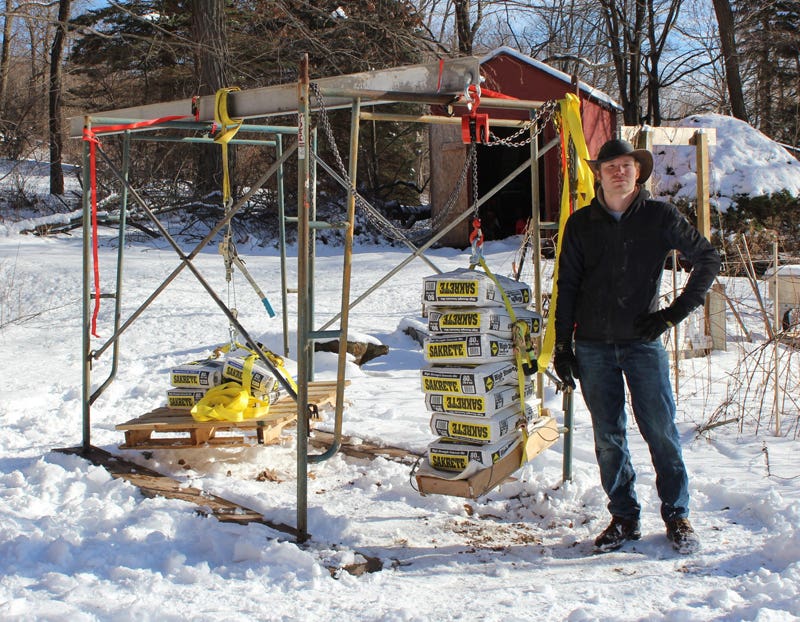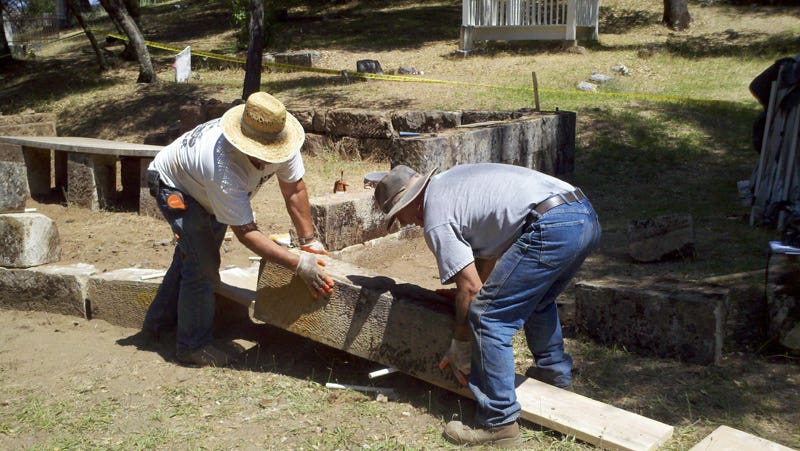Falling Forward, Standing Back
Up until recently Rudy Christian and I have shared his blog, A Place for Trades. As friends we would alternate back and forth, sometimes we would bounce our ideas off…


Up until recently Rudy Christian and I have shared his blog, A Place for Trades. As friends we would alternate back and forth, sometimes we would bounce our ideas off each other, other times we would wander off alone into our own unique heritage conservation worlds. I may now announce by the good grace of Traditional Building that I am to write a blog titled Falling Forward, Standing Back.
Falling Forward is how I feel most of the time when I am engaged in work of any sort. It is always a crazy, mixed up, sometimes desperate, mad rush to the end of a goal.
In youth in my home area I used to enjoy to go to the local sand and gravel pit, then up top to jump over the edge and run down the hill as the sand and gravel drifted below me (not recommended unless you are a professional). Or, in town, to pick a steep hill and run down the sidewalk. It felt like flying. One needs to keep on the run as once there is any hesitation then there is the risk of a wipe out, possibility to land on the face, or break an arm or leg. Skid marks.
This is how I see doing business. Always at the risk of a crash and burn. One can work very hard to build up a talent to be able to do a particular thing, like to hit a stone with a hammer and to miss the hand, then suddenly slam the hammer down on the thumb and rip out the nail. Trust me, it hurts.
Standing back is the space of ‘those not doing very much of anything’ times and an opportunity to think through, “Maybe that running was not such a good idea after all.” Or, then again, “Maybe I should be more cautious when I put my hand in front of the hammer swing.”
In every column I will be dedicated to providing some hands-on knowledge of a particular technique or tidbit of information, and whenever possible a comment about something going on in the preservation industry of a social nature, like a conference or a workshop or a UFO siting (Oops, I was not supposed to mention the Mother Ship lifting up the Egyptian obelisk and setting it back down in my neighbor’s yard.).
So here goes. When you need to move heavy stones from the ground up into the air you can use a strong wooden plank and rollers. In the past I used to use wooden broom handles cut into short lengths as rollers, but these days I prefer to get hold of some PVC pipe and cut it into lengths. Though this may seem like ancient history to some folk, particularly to stone masons, these two guys that I worked with at a cemetery in California had never considered the technique of a plank and rollers. They were of the mind, “Well, just pick it up.”
Of course, there are some folk that prefer to do everything the oldest fashion way that they can manage, it may give them a sense of authenticity, but lifting stones can put your body in a bad way in a hurry. Rollers are great. One time I had to move an old refrigerator by myself. I tipped it over then rolled it around on an empty beer can. I have yet to see Rudy Christian do this.
And if you get really into moving heavy things around without the use of power equipment then there are a number of fun ways to go about it. In this case we had to move a 15 x 11-ft. granite wall, made up of nine (9) stones at 500 lbs. a piece. The wall is carved as a relief map of the world and has a bronze star at each location where a NYC Transit Employee died during World War II. It was my project to move the wall 20 years ago, which I did with a friend, and this last year my son and I at work together moved the wall once again. Stay tuned and I may write about it in a future blog. But here we are doing a load test.
If you have been reading then you may recognize that I like to write about simple actions, small notices of the day and the work world, and the occasional pretty stupid thing that I have done along the way.
I have been going around asking my peers, fellow traditional trades practitioners, what makes them tick, what keeps them going and why do they persist.
What keeps us going?
My maternal grandfather was a Master Finish Carpenter; his specialty was spiral staircases. At the end of his career and the beginning of his too-short retirement, when I was a fresh 18 years of age, I asked him why he had decided to take up his trade. His response, “It seemed like a good idea at the time.” Of all my friends that I ask I hear all sorts of answers, but when they boil their bull down to the bottom of the kettle there is just this one answer, that it seemed like a good idea at the time. From there on, once that decision is made, it is all about falling forward.
A friend reflected recently the analogy that for him it is like rowing a boat. He cannot see where he is going, he is rowing like crazy, and he is guided by the view of where he has been. Personally I prefer a kayak. I know that we do not know our future, but I sure do like to pretend that I can see it.
I am interested in what is in people’s heads that decide them to take up hands-on traditional trades work. I am decidedly appreciative of satisfaction in the tactile activity of work with materials with the hands, but in historic work there is always more than the physical pleasure of work with the heart, the spirit, an appreciation of the past, a romantic vision, or a quaky idealism that drives a person along to choose a life of traditional trades work.
Along these lines I want to hear what you have to say.
Ken Follett is a founding member and 1st past president of the Preservation Trades Network as well as a longtime member of APTI and APT Northeast. Based in Putnam County, NY, his work is primarily in the NY/CT/NJ region with occasional stints in places such as Washington, DC, and Coloma, CA. His trade background is in masonry with an emphasis on playing with stone. Beyond stone, Ken has several decades of contract experience in project estimating, administration and management. Most notably in terms of education was his two and a half years as clerk-of-the-works on a $20M redevelopment project in Harlem for the NYC Transit Authority.
Currently Ken works in partnership with his son David Follett to provide in-field support services to structural engineers, architects and conservators in their design investigations of existing and historic structures. As a hands-on project consultant, Ken assists project teams in resolution of heritage conservation problems, most recently to resolve a project-killing issue for the award winning Eberhard Pencil Factory buildings at 58 Kent Street in Greenpoint, Brooklyn. Ken also gets involved in small projects, such as deconstructing and reconstructing a Stanford White fireplace, designated mason in a Guastavino tile vault workshop, righting a tipped cemetery obelisk, or matching an existing custom stucco recipe. Ken also works with heritage contractors as well as materials suppliers, assisting them in their business development.
For eighteen years Ken was executive vice-president of a specialty historic restoration contracting firm in Brooklyn, NY. In the role of contractor Ken was responsible for the negotiation, planning and project management (for which Christian & Son was a team member) to relocate Thomas Edison’s #11 laboratory building from the Henry Ford Museum in Dearborn, MI, to its original site in West Orange, NJ. Of similar note was assisting the design investigation team for the Edison Memorial Tower in Menlo Park, NJ (a John Early concrete panel structure). He was also involved in the preconstruction and probe investigation activities for both the New Amsterdam Theater and the Grand Central Retail Redevelopment projects in NYC. Another project of note, involving public art, was the demounting and conservation of the Paul Manship Medallions from the NY Coliseum that were relocated and mounted at the Brooklyn Battery Tunnel Ventilation Building in Manhattan at the north side of Battery Park. Ken was the contractor and project manager for the multiple award winning exterior restoration of the Barnes & Noble corporate headquarters at the north end of Union Square in Manhattan, New York.
As a writer Ken has over the years published in a number of venues including Traditional Building, Building Renovation, CRM, APT Bulletin and APT Communiqué. Otherwise Ken speaks in public rarely, prefers to encourage and enable the more bold and outspoken, and even more rarely will direct a workshop (estimating for heritage conservation work)… though he has organized quite a few workshop and work experiences for others.
Experienced in contract procedure with the following public agencies: NYC Historic House Trust, GSA, U.S. Navy, U.S. Marine Corps, US Coast Guard, National Park Service, FDA, HUD, NYCTA, MTA Bridges & Tunnels, NYC DDC, and NYC Parks.






